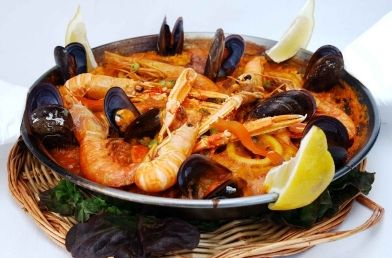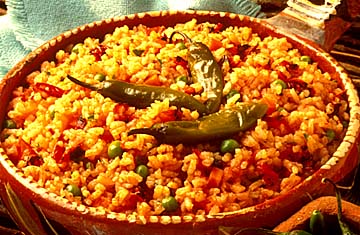Spanish Food Recipes Biography
Source(google.com.pk)The Zhou Dynasty was the most prosperous period of the slave society, and during this time politics, economics and culture advanced greatly. It was the strongest of the three slave dynasties: Xia, Shang and Zhou.
The imperial cuisine of the Zhou Dynasty was a great improvement over the cuisines of the Xia and Shang dynasties. Beginning with the construction of the Xia Dynasty palace and the establishment of the imperial court, an organization was set up to prepare and serve food to the emperor and empress. Officials were appointed, royalty began seeking pleasures, and an imperial kitchen system was conceived.
The Shang Dynasty imperial cuisine was even better than the cuisine of the Xia Dynasty. The foods for the emperors, princes, and dukes were stratified, and a system of stratified foods for the nobility was developed, however, a system for managing imperial food was still lacking.
During the Zhou Dynasty, such a complete system was developed. It included procurement, diets and preparation as well as staffing, supervising the imperial food, and developing grades for the emperor, princes and dukes. Everything was done in a fixed order according to the “eating rites.”
The Zhou Dynasty imperial food was of a higher standard than the imperial food of the Xia and Shang dynasties, and famous dishes, feasts and banquets appeared one after another. During the Zhou Dynasty, Chinese imperial cuisine took shape. Staple and non-staple foods were plentiful and many imperial and famous dishes were developed.
Jamie's major project for 2008, however, was Jamie's Ministry of Food, a Channel 4 TV series which showed how people who couldn't cook could be inspired to cook with just a little encouragement and information. The series, filmed in Rotherham, explored how friends, family and work-mates could be inspired to pass on recipes to each other and cook using fresh ingredients. Additionally, a Ministry of Food centre set-up by Jamie in the town centre has been providing information, cooking lessons and advice to the townsfolk who want to move away from take-aways and ready-meals. After the success of the Ministry of Food centre, Rotherham Council announced it would continue to fund the running of the centre and in 2010, the Rotherham Ministry of Food centre is so successful that its classes are booked many weeks in advance. A second Ministry centre opened in Bradford in November 2009 and a third in Leeds in April 2010. Many other UK councils are seriously looking at opening similar centres to try to halt Britain's growing obesity problem.
A book, Jamie's Ministry of Food was published by Michael Joseph in October 2008 and quickly became one of Jamie's most successful books both in the UK and internationally.
In early 2009, Jamie was typically busy. On television he tackled the issue of pig welfare and the need to champion British pig farmers in the Channel 4 one-off programme Jamie Saves Our Bacon. He also announced a new high street cooking shop project called Recipease, the first of which opened in Battersea/Clapham Junction in February quickly followed by a second shop in Brighton in May.
The year also saw the launch of Jamie at Home, an exciting direct selling business which empowers people to start their own businesses by selling Jamie's quality products through holding parties for friends and colleagues. For more info – www.jamieathome.com
On April 1st, Jamie had the great honour of cooking at 10 Downing Street for the third time in his career, this time for the assembled world leaders in advance of the G20 talks. He and a group of graduates and an apprentice from Fifteen London cooked a menu showing off the best of seasonal British food. Just over 24 hours later, Jamie was celebrating the birth of his third daughter – Petal Blossom Rainbow.
Jamie spent much of 2009 in the USA, first making a series for Channel 4 (and overseas markets), Jamie's American Road Trip, during which he visited Los Angeles (meeting Mexican ex-gang members who are being rehabilitated through food and cooking), Wyoming (where he spent time with cowboys living in a wilderness that has barely changed for centuries), New York (where he strayed from the typical tourist areas to discover delicious food from the Peruvian, Colombian, Egyptian and Chinese communities), Louisiana (hunting alligators and helping to get a restaurant damaged by a hurricane back on its feet), Georgia (investigating soul food and the southern of barbecuing) and Arizona (where Jamie spent time with the Navajo people and learnt about their food and culture). An accompanying book, Jamie's America, became Jamie's 10th best-seller.
Late in 2009, Jamie launched an iPhone app called 20 Minute Meals which quickly became a best-seller and a huge hit with the app-loving public in the UK and overseas as well as winning the much coveted Apple Design Award for apps.
The fairly advanced economy in the Western Zhou Dynasty resulted in abundant cereals, vegetables and meats. The cereals available included rice, corn, millet and beans. The Book of Songs states there were in excess of 130 plants, which included more than 30 kinds of common vegetables. Fruits and nuts included peach, plum, apricot, date, wild jujube (Chinese date), chestnut, hazelnut, pear, sweet crabapple, persimmon, melons, cherry, orange, tangerine and shaddock (a fruit similar to a grapefruit).
Around 100 different animals were available. These included the ox, sheep, dog, pig, horse, deer, bear, wolf and elephant. There were several dozen varieties of fowl, such as the chicken, peasant, sparrow, and wild goose; and nearly 20 kinds of cold-blooded creatures including the carp, triangular bream, turtle, snake and shark. The imperial cuisine used these abundant meats, fish, fowl, cereals, fresh fruits and vegetables, and nuts as well as vegetables pickled in vinegar and soy sauce.
Spanish Food Recipes Food Recipes for Dinner For Kds with Pictures In Urdu Desserts Pinoy In Hindi in Sinhala Language for Kids to Make in Sri Lanka

Spanish Food Recipes Food Recipes for Dinner For Kds with Pictures In Urdu Desserts Pinoy In Hindi in Sinhala Language for Kids to Make in Sri Lanka

Spanish Food Recipes Food Recipes for Dinner For Kds with Pictures In Urdu Desserts Pinoy In Hindi in Sinhala Language for Kids to Make in Sri Lanka

Spanish Food Recipes Food Recipes for Dinner For Kds with Pictures In Urdu Desserts Pinoy In Hindi in Sinhala Language for Kids to Make in Sri Lanka

Spanish Food Recipes Food Recipes for Dinner For Kds with Pictures In Urdu Desserts Pinoy In Hindi in Sinhala Language for Kids to Make in Sri Lanka

Spanish Food Recipes Food Recipes for Dinner For Kds with Pictures In Urdu Desserts Pinoy In Hindi in Sinhala Language for Kids to Make in Sri Lanka

Spanish Food Recipes Food Recipes for Dinner For Kds with Pictures In Urdu Desserts Pinoy In Hindi in Sinhala Language for Kids to Make in Sri Lanka

Spanish Food Recipes Food Recipes for Dinner For Kds with Pictures In Urdu Desserts Pinoy In Hindi in Sinhala Language for Kids to Make in Sri Lanka

Spanish Food Recipes Food Recipes for Dinner For Kds with Pictures In Urdu Desserts Pinoy In Hindi in Sinhala Language for Kids to Make in Sri Lanka

Spanish Food Recipes Food Recipes for Dinner For Kds with Pictures In Urdu Desserts Pinoy In Hindi in Sinhala Language for Kids to Make in Sri Lanka

No comments:
Post a Comment